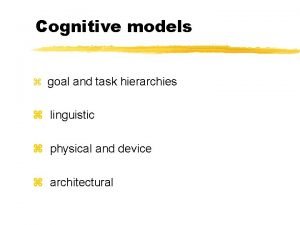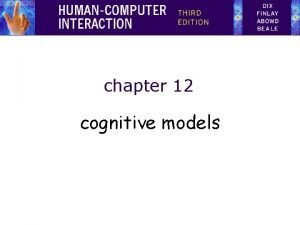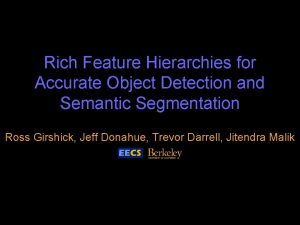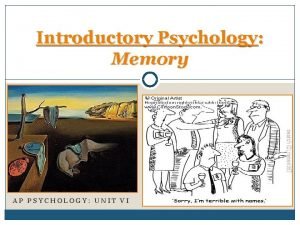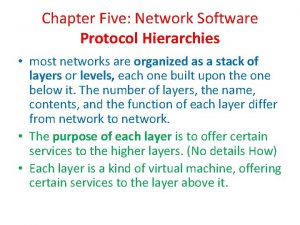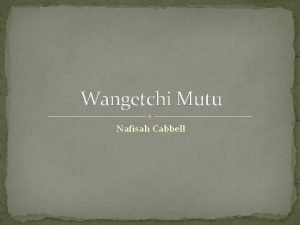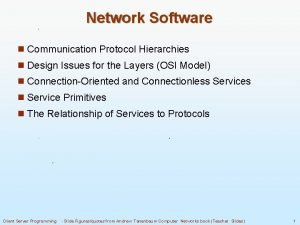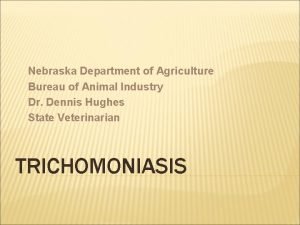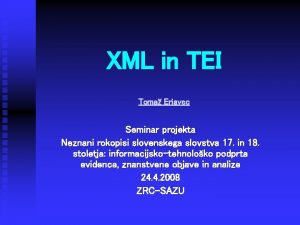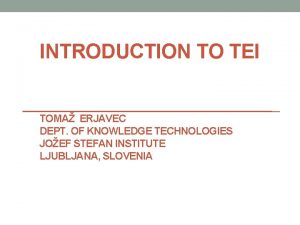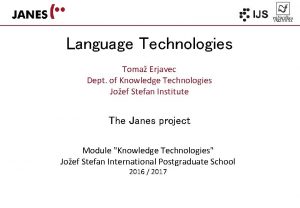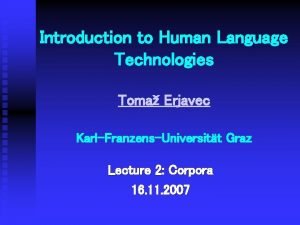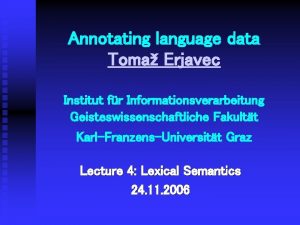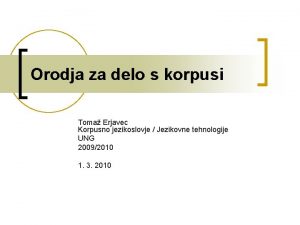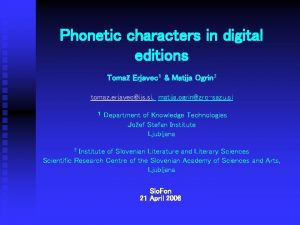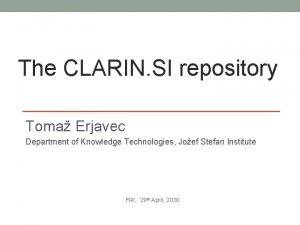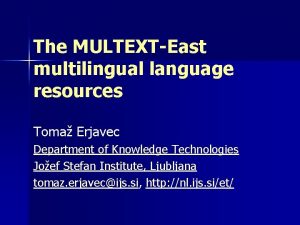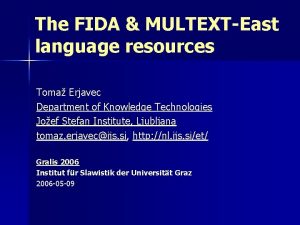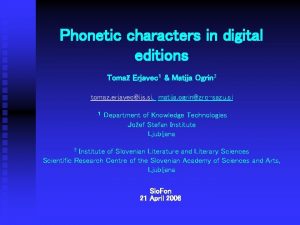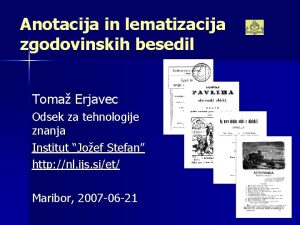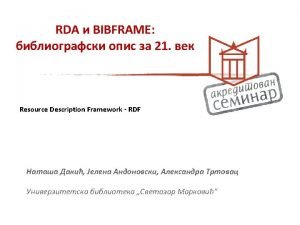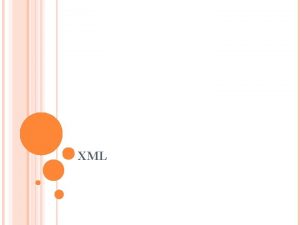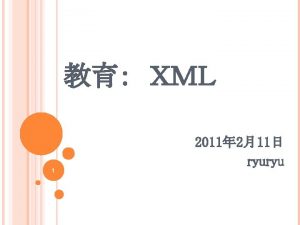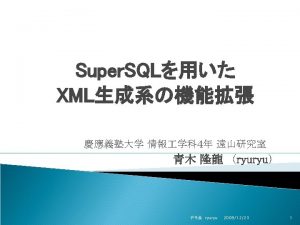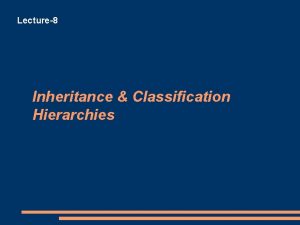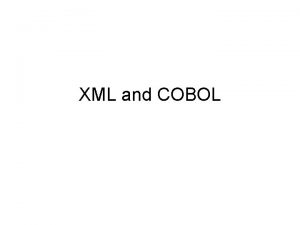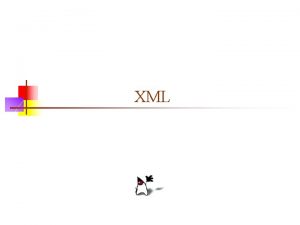XML and overlapping hierarchies Toma Erjavec Dept of








































- Slides: 40

XML and overlapping hierarchies Tomaž Erjavec Dept. of Knowledge Technologies Jožef Stefan Institute Ljubljana Slovenia Tsujii Laboratory University of Tokyo 9. 1. 2007

Overview 1. 2. 3. 4. the problem in-line methods 1. fragmented markup 2. milestones stand-off methods 1. multiple annotation 2. using pointers GENIA Tomaž Erjavec: XML and overlapping hierarchies

The OHCO concept Text as Ordered Hierarchy of Content Objects (OHCO) n. . each structure properly nests within the higher level one n XML is a tree-modelling language - well suited for OHCO representations n however, not all structures are tree-like. . n Tomaž Erjavec: XML and overlapping hierarchies

Main problem: crossing hierarchies Tomaž Erjavec: XML and overlapping hierarchies

Problems in Humanities research ~ text modelling n n n layout vs. paragraph structure: <page> … <p> … </page> … </p> paragraph vs. reported speech: <p> … <q> … </p> … </q> metrical vs. syntactic structure: <l><s>…. </l>…. </s> etc. research in the humanities - mostly done in the domain of so called text-critical editions and transcriptions of primary sources Tomaž Erjavec: XML and overlapping hierarchies

Gustave Flaubert: Madame Bovary, Library of Rouen Tomaž Erjavec: XML and overlapping hierarchies A complex case Jean-Daniel Fekete IN|SITU| Project INRIA Futurs, France http: //insitu. lri. fr/~fekete /

Many proposals! From: C. M. Sperberg-Mc. Queen. Rabbit/duck grammars: a validation method for overlapping structures. Extreme Markup Languages 2006. Montréal, Québec: …ways of dealing with non-hierarchical information; see, for example, [Barnard et al. 1988], [Renear et al. 1993], [Barnard et al. 1995], [Huitfeldt 1995], [Murata 1995], [Durand et al. 1996]. Out-of-line or standoff markup [Dybkjær et al. 1998], fragmentation of elements, milestone elements, virtual elements (e. g. [Barnard et al. 1988], [ACH/ACL/ALLC 1994], [Barnard et al. 1995]), concurrent structures [ISO 1986] [Sperberg-Mc. Queen / Huitfeldt 1999], MECS [Huitfeldt 1999], parallel encoding (e. g. [Witt 2004], [Hilbert et al. 2005], [Dekhtyar / Iacob 2005]), bottom-up virtual hierarchies [Durusau / O'Donnell 2002 a], layered markup and annotation (LMNL) [Tennison / Piez 2002], range algebra [Nicol 2002], just-in-time trees [Durusau / O'Donnell 2002 b], multi-colored trees [Jagadish et al. 2004], tables [Durusau / O'Donnell 2004], Tex. Mecs [Huitfeldt / Sperberg-Mc. Queen 2001], Goddag structures [Sperberg-Mc. Queen / Huitfeldt 2000], Trojan horses [De. Rose 2004] Tomaž Erjavec: XML and overlapping hierarchies

Problems in NLP ~ corpus annotation n n probably the most work in this area has been done for annotation of speech corpora, dialogues and discourse structure crossing hierarchies: phonological / morphemic; discourse / syntactic discontinuous constituents: syntax, multi-word expressions, disfluencies u note that in NLP a similar problem occurs with parsing also: annotation of same level by different tools Tomaž Erjavec: XML and overlapping hierarchies

Example: dialogue vs. syntactic annotation from: Jean Carletta, David Mc. Kelvie, and Amy Isard: : Supporting linguistic annotation using XML and stylesheets. In Readings in Corpus Linguistics, ed. G. Sampson and D. Mc. Carthy, London and NY: Continuum International, 2002. Tomaž Erjavec: XML and overlapping hierarchies

Solutions n n In-line markup: u modified markup is included in the text file u main advantage: text / markup can still be (partially) hand edited and validated u favoured by the humanities community u main standard used: t TEI Stand-off markup: u markup is stored separately, and points to text u main advantage: any relationship can be expressed u favoured by the NLP community u main standard (beginning to be) used: t ISO TC 37 SC 4 proposals Tomaž Erjavec: XML and overlapping hierarchies

Types of overlap (adapted from: Patrick Durusau, Matthew Brook O'Donnell. Concurrent Markup for XML Documents. XML Europe 2002) Tomaž Erjavec: XML and overlapping hierarchies

In-line solutions n n n standard approaches: u fragmented markup u milestones alternatives: BUVH, etc. non-XML approaches: u Tex. MECS u JITT u LMNL Tomaž Erjavec: XML and overlapping hierarchies

Fragmented markup n n n One hierarchy taken as primary, for the other(s) the markup is modified so that each “crossing” element is split Non-well formed structure: <p><s>According to the visiting leader, the economy of the country is <q>"better than ever. </s><s>It is in fact in very good shape. </s>"</q></p> With fragmented <q>: <p><s>According to the visiting leader, the economy of the country is <q id=“q 1” next=“q 2”>"better than ever. </q></s><q id=“q 2” prev=“q 1”><s>It is in fact in very good shape. </s>"</q></p> Tomaž Erjavec: XML and overlapping hierarchies

Fragmented markup II n n Advantages: u retains as much as possible of the structure u XML schema need not be changed u not very difficult to implement Disadvantages: u one hierarchy arbitrarily chosen as the primary one u needs special (XSLT, XQuery) constructs to implement u elements have be broken up into many pieces if: t secondary hierarchy crosses multiple branches of primary one t we have to deal with multiple hierarchies Tomaž Erjavec: XML and overlapping hierarchies

Milestones n n Container elements are substituted by empty elements Example: u Non-well formed structure: <p><s>According to the visiting leader, the economy of the country is <q>"better than ever. </s><s>It is in fact in very good shape. </s>"</q></p> u With milestone <q>: <p><s>According to the visiting leader, the economy of the country is <q-start id=“q 1” coid=“q 2”/>"better than ever. </s><s>It is in fact in very good shape. </s>"</q-end id=“q 2” coid=“q 1”></p> Choices: only broken or all elements can be milestoned Best type of milestones, so called Troyan milestones used by OSIS: u use <q who='paris'>. . . </q> when you can, otherwise u use <q who='paris' s. ID='foo'/>. . . <q e. ID='foo'/> Tomaž Erjavec: XML and overlapping hierarchies

Milestones II n n Advantages: u conceptually simple u can express any type of overlap u simple to change to/from other formats Disadvantages: u retain no structure in the document - very hard or impossible to do validation or querying u have to (substantially) change the schema Tomaž Erjavec: XML and overlapping hierarchies

Non-XML approaches n n These approaches introduce new syntax and semantics best known probably MECS / Tex. MECS: Huitfeldt, Claus, and C. M. Sperberg-Mc. Queen. 2001. “Tex. MECS: An experimental markup meta-language for complex documents”. http: //helmer. aksis. uib. no/claus/mlcd/papers/texmecs. html n example: {sp{{speaker{AASE}speaker}{l{Peer, you're lying!}-l}}sp} {sp{{speaker{PEER GYNT }speaker} {stage{without stopping}stage}{+l{No, I'm not!}l}}sp} {sp{{speaker{AASE}speaker}{l{Well then, swear to me it's true. }l}}sp} {sp{{speaker{PEER GYNT}speaker}{l{Swear? why should I? }-l}}sp} {sp{{speaker{AASE}speaker}{+l{See, you dare not!}l} {l{Every word of it's a lie. }l}}sp} Tomaž Erjavec: XML and overlapping hierarchies

XML in-line solutions - conclusions n n n it is still possible to modify text and (partially) markup partial XML validation still possible, although schema might need to be changed smaller or greater problems with using standard methods of extracting information (XPath, XQuery) become less advantageous as number of different levels grow we might not want to deal with all the markup all the time Tomaž Erjavec: XML and overlapping hierarchies

Stand-off solutions n n Markup is separated from text markup points to text using XLink (dis)advantages: any type of relationships possible Methods discussed: u hybrid approaches: t joins t multiple annotations u pure stand-off: t pointers (& tools) t RDF Tomaž Erjavec: XML and overlapping hierarchies

Joins n n “semi stand-off markup” introduced by TEI advantage: power - any relationship can be expressed disadvantage: join object is not (in general) contiguous with the segments it is joining Tomaž Erjavec: XML and overlapping hierarchies

Join-like syntactic annotation Used in the TIGER treebank of German Tomaž Erjavec: XML and overlapping hierarchies

Multiple Annotation n n n Developed by Andreas Witt, Bielefeld University, c. f. http: //www. text -technology. de/, Sekimo project each annotation layer is a separate XML document, which contains both markup and text the text serves as the implicit link text has two representations: u as XML documents u as a Prolog database they can be programmatically derived and used together for editing, inference, or unification of the multiply annotated document advantages: u each level can be viewed separately u simple to add new levels Tomaž Erjavec: XML and overlapping hierarchies

Multiple Annotations II Prolog representation for elements: node(‘d-xhtml. xml', 729, 786, [1, 5, 3, 2], element('td')). node(‘d-xhtml. xml', 729, 786, [1, 5, 3, 2, 1], element('ul')). node(‘d-xhtml. xml', 729, 751, [1, 5, 3, 2, 1, 1], element('li')). node(‘d-thema. xml', 729, 786, [1, 5, 3, 2], element('causes')). node(‘d-thema. xml', 729, 751, [1, 5, 3, 2, 1], element('cause')). Similar structure for attributes: attr('tape-xhtml. xml', 729, 786, [1, 5, 3, 2], 'valign', 'top'). For PCDATA: pcdata_node(729, pcdata_node(730, pcdata_node(731, pcdata_node(732, pcdata_node(733, pcdata_node(734, Tomaž Erjavec: XML and overlapping hierarchies 730, 731, 732, 733, 734, 735, 'N'). 'o'). 'c'). 'a'). ‘t'). (adapted from Andreas Witt. Multiple hierarchies: new aspects of an old solution. Extreme Markup Languages 2004, Montréal, Québec)

Multiple Annotations III Software support: n xml 2 prolog. py XML documents to Prolog n nexus. pl Prolog to NITE format n semt. pl Prolog to XML (milestone/fragmentation of incompatible elements) n markup can be modified with standard programs n text can be edited with 2 specialised editors n programs are freely available n performance might be an issue Tomaž Erjavec: XML and overlapping hierarchies

“Proper” pointers n n used by most NLP approaches, also for “proper” hierarchies no (or only basic) markup present in text markup separated into one or several distinct files XPointer/XLink attributes to point to IDs or simply text offsets Tomaž Erjavec: XML and overlapping hierarchies

Pointers II n n advantages: power - any relationship can be expressed disadvantages: u very difficult to perform validation u (difficult to query the data) u difficult to change the annotations u impossible to change the text this approach best for “read only” systems: annotations and esp. text are fixed, the only interest is in accessing the data still, lots of annotation tools exist that know how to deal with stand-off annotations Tomaž Erjavec: XML and overlapping hierarchies

Tool: Monet. DB/XQuery Alink et al. Representing and Querying Multi-dimensional Markup for Question Answering. NLPXML-2006, Trento, Italy n n n supports overlapping markup source text, or character data, is stored as a Binary Large OBject (BLOB) all annotations stored in a single XML document, pointing to BLOB with offsets querying performed with extended XQuery system, reported to be very fast and scalable, is implemented in a special (open source) DB Monet. DB/XQuery Tomaž Erjavec: XML and overlapping hierarchies

Monet. DB/XQuery II Main innovation: 4 new XPath axes n e. g. XML document: <A start="10" end="50"> <B start="30" end="50"/> </A> <E start="20" end="60"> <C start="20" end="40"/> <D start="55" end="60"> </E> n n n //B/select-wide: : * returns all nodes that overlap with the span of a B node: in our case A, B, C and E. //*[. /select-narrow: : B] returns nodes that contain the span of B: in our case, A and E. Tomaž Erjavec: XML and overlapping hierarchies

Tool: NITE http: //www. ltg. ed. ac. uk/NITE n n NITE XML Toolkit (NXT) is open source Java software for working with multimodal, spoken, or text language corpora designed to support the tasks of human annotators and analysts of heavily crossannotated data sets allows combination of multiple audio and video signals with crossing structures of linguistic annotation has been already used on a range of projects with varying needs Tomaž Erjavec: XML and overlapping hierarchies

NITE and crossing hierarchies n n n NITE uses its internal data representation based on multi -rooted trees: nodes can have one set of children, but multiple parents from different upward trees data is serialized into XML by dividing the multi-rooted tree into convenient trees where the XML structure mirrors the data structure and representing the remaining connections between nodes using stand-off links with XLink NXT Search: stand-alone program to query NITE-type annotated corpora u uses special syntax for querying Tomaž Erjavec: XML and overlapping hierarchies

Other tools Quite a few other (well-known) tools use stand-off markup: n Callisto, n MMAX, n AGTK (Annotation Graph Toolkit) n ATLAS (Architecture and Tools for Linguistic Analysis Systems) n Wordfreak n etc. Tomaž Erjavec: XML and overlapping hierarchies

Radical Stand-off: RDF n n n The Resource Description Framework is a language intended for representing metadata about Web resources. RDF identifies things using URIs RDF describes resources in terms of simple properties and property values RDF statements can be represented as a graph of nodes and arcs representing the resources, their properties and values RDF provides an XML-based syntax (called RDF/XML) for recording and exchanging these graphs RDF is the main language of the Semantic Web, e. g. it is the basis of OWL, the Ontology Web Language Tomaž Erjavec: XML and overlapping hierarchies

Simple RDF example n Example of a statement about a Web page: http: //www. example. org/index. html has a creator whose value is John Smith n n n RDF terms for the 3 parts of these statement are: u subject: http: //www. example. org/index. html u predicate: creator u object: John Smith All 3 are URI references, e. g. u subject URI, e. g. http: //www. example. org/index. html u predicate URI, e. g. http: //purl. org/dc/elements/1. 1/creator u object URI, e. g. http: //www. example. org/staffid/85740 RDF graph: Tomaž Erjavec: XML and overlapping hierarchies

Using RDF for linguistic annotation Aguado de Cea et al. RDF(S)/XML linguistic annotation of semantic web pages. 2 nd workshop on NLP and XML, 2002. n n n example gives morphosyntactic annotations with three taggers they also describe syntactic and semantic annotation however, no tools for querying such structures are presented Tomaž Erjavec: XML and overlapping hierarchies

Annotea n n n W 3 C project for annotating Web pages uses Annotea server, where people can deposit notes / comments on regions of Web pages uses RDF Web pages + annotations can be viewed with an Annotea aware Web browser Basic idea similar to corpus annotation But annotations much less dense, and more dispersed Tomaž Erjavec: XML and overlapping hierarchies

Why is RDF not more popular? Still a big divide between the Semantic Web and the NLP communities? n Data structures are very large, larger than is necessary even with stand-off annotation n No tools yet exist that would support RDF corpus annotations n Tomaž Erjavec: XML and overlapping hierarchies

Stand-off solutions - conclusions n n n can represent any relationship between structures difficult to use standard XML methods (XPath, XQuery) to extract information difficult to validate structures difficult to manually modify markup impossible to modify text → useful only with specialised tools to operationalise such markup Tomaž Erjavec: XML and overlapping hierarchies

Overlapping Markup Desiderata Steven De. Rose. Markup Overlap: A Review and a Horse in Extreme Markup Languages 2004 (Montréal, Québec) n n n Adequacy Human readability Maintainability Available implementations XML compatibility Ease of validation Validation across hierarchies Ease of formatting Ease of extracting multiple views Ease of extracting hierarchical subsets Continuity of text content Tomaž Erjavec: XML and overlapping hierarchies

GENIA n n n several copies of the corpus, each annotated with different linguistic information at certain points the text itself differs how to merge the separate copies into one corpus? how to query over all / subsets of the annotations? how to ensure easy addition of further annotations? Tomaž Erjavec: XML and overlapping hierarchies

Conclusions n n Many different approaches, with different strengths and weaknesses In-line approaches can - to an extent - rely on existing XML technologies Stand-off approaches need special tools u however, quite a few exist For GENIA, maybe: u Hand editing of text: Milestones u Maintaining separate copies: Multiple annotations u Fast and flexible querying: Monet/XQuery Tomaž Erjavec: XML and overlapping hierarchies
 Tedovit
Tedovit Gimnazija jesenice
Gimnazija jesenice Goal and task hierarchy model
Goal and task hierarchy model Issues for goal hierarchies
Issues for goal hierarchies Rich feature hierarchies for accurate object detection
Rich feature hierarchies for accurate object detection Source monitoring
Source monitoring Network software protocol hierarchies
Network software protocol hierarchies Misguided little unforgivable hierarchies
Misguided little unforgivable hierarchies Protocol hierarchies
Protocol hierarchies Department of finance and administration
Department of finance and administration Florida dept of agriculture and consumer services
Florida dept of agriculture and consumer services Florida dept of agriculture and consumer services
Florida dept of agriculture and consumer services Florida department of agriculture and consumer services
Florida department of agriculture and consumer services Dept nmr spectroscopy
Dept nmr spectroscopy Organizational structure of finance department
Organizational structure of finance department Worcester public health department
Worcester public health department Dept. name of organization (of affiliation)
Dept. name of organization (of affiliation) Mn dept of education
Mn dept of education Dept. name of organization (of affiliation)
Dept. name of organization (of affiliation) Ohio dept of dd
Ohio dept of dd Affiliation poster
Affiliation poster Vaginal dept
Vaginal dept Gome dept
Gome dept Gome dept
Gome dept Gome dept
Gome dept Gome dept
Gome dept Hoe dept
Hoe dept Firefighter interview tips
Firefighter interview tips Maine department of agriculture conservation and forestry
Maine department of agriculture conservation and forestry Dept of education
Dept of education Dept a
Dept a Central islip fire dept
Central islip fire dept Rowan county dept of social services
Rowan county dept of social services Dept of education
Dept of education Bromocicloesano
Bromocicloesano Pt dept logistik
Pt dept logistik Nys department of homeland security
Nys department of homeland security La dept of revenue
La dept of revenue La geaux biz
La geaux biz Continuing education library oxford
Continuing education library oxford Nebraska dept of agriculture
Nebraska dept of agriculture


